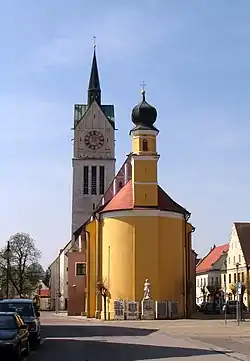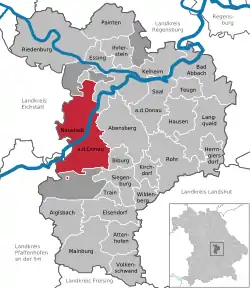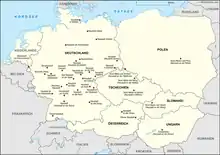Neustadt an der Donau
Neustadt an der Donau is a town in Lower Bavaria on the Danube in Bavaria, Germany. Lying on the western border of Landkreis Kelheim, Neustadt is primarily known for the thermal spa Bad Gögging. Neustadt had a population of 12,753 as of December 31, 2003.
Neustadt a.d.Donau | |
|---|---|
 Saint Lawrence Church and Saint Anne Chapel | |
 Coat of arms | |
Location of Neustadt a.d.Donau within Kelheim district  | |
 Neustadt a.d.Donau  Neustadt a.d.Donau | |
| Coordinates: 48°48′N 11°46′E | |
| Country | Germany |
| State | Bavaria |
| Admin. region | Niederbayern |
| District | Kelheim |
| Government | |
| • Mayor | Thomas Reimer (SPD) |
| Area | |
| • Total | 93.56 km2 (36.12 sq mi) |
| Elevation | 354 m (1,161 ft) |
| Population (2019-12-31)[1] | |
| • Total | 14,604 |
| • Density | 160/km2 (400/sq mi) |
| Time zone | UTC+01:00 (CET) |
| • Summer (DST) | UTC+02:00 (CEST) |
| Postal codes | 93333 |
| Dialling codes | 09445 09444 (Mühlhausen) 08402 (Schwaig, Umbertshausen) |
| Vehicle registration | KEH |
| Website | www.neustadt-donau.de |
- Neustadt an der Donau is also the German translation of Dunaújváros in Hungary.
Geography

The city is located halfway between Ingolstadt and Regensburg, on an approximately 5 kilometres (3.1 mi) wide gravel plain of the Danube valley, which at this point is south of the wooded foothills of the tertiary Donau-Isar hill country of the Hallertau and bounded on the north by the limestone slope of the southern Franconian Alb. The rivers Ilm and Abens flow into the Danube in the city.
The township includes 22 districts Arresting, Bad Gögging, Deisenhofen, Eining, Geibenstetten, Haderfleck, Heiligenstadt, Hienheim, Irnsing, Irnsing-Steinbruch, Karpfenstein, Lina, Marching, Mauern, Mulhouse, Niederulrain, Oberulrain, Schwaig, Sittling, Umbertshausen and Wöhr .[2] The area heavily dominated by agriculture; asparagus and in particular hops play a special role. Neighboring communities of Neustadt are Abensberg, Altmannstein, Biburg, Kelheim, Mindelstetten, Münchsmünster, Pförring and Siegenburg.
History

The oldest documented area of Neustadt was the village of Trephenau.[3] Under the name Seligenstadt the town charter was granted in May 1273 by Duke Ludwig II. This town charter is the oldest in Bavaria. With the town survey and the consequent new investment and resettlement Duke Ludwig II secured the Danube Valley road and the river crossing. The town charter is one of many granted by early Wittelsbach dukes as part of a planned foundation of towns. Neustadt was first mentioned by that name in a document of Abbot Conrad of Weltenburg from 1277.
The settlement of Wöhr, just outside the city gate on the bank of the Danube, is actually older than Neustadt. The name derives from the Middle High German Wert, signifying an island of elevated dry land. Wöhr was incorporated in the late Middle Ages as part of the city of Neustadt and residents of Wöhr could be citizens of the city, but lived outside the fortification. Wöhr was also the seat of the noble family of the Lords of Wöhr and the ducal Urbar Office "ze Werde" that managed the natural and monetary levies from the ducal estates.
Population development
- 1961: 7.678
- 1998: 12.125
Personalities
- Eberhard of Salzburg (* around 1085 in Sittling-1164 in the Cistercian monastery Rein), Archbishop of Salzburg from 1147 to 1164, was venerated as a holy
- Wilhelm Sander (died 1973 in Neustadt an der Donau), manufacturer and donor
- Jürgen Wittmann (born 1966 in Neustadt an der Donau), German football goalkeeper
References
- "Tabellenblatt "Daten 2", Statistischer Bericht A1200C 202041 Einwohnerzahlen der Gemeinden, Kreise und Regierungsbezirke". Bayerisches Landesamt für Statistik und Datenverarbeitung (in German). July 2020.
- Bayerische Landesbibliothek Online.
- Köglmeier, Georg (1994). "Neustadt an der Donau : Band 1; Von den Anfängen bis um 1800. eine bayerische Landstadt und ihre Bewohner im Wandel der Jahrhunderte".
External links
| Wikimedia Commons has media related to Neustadt an der Donau. |
- (in German) Municipal website
- (in German) Official website of Bad Gögging